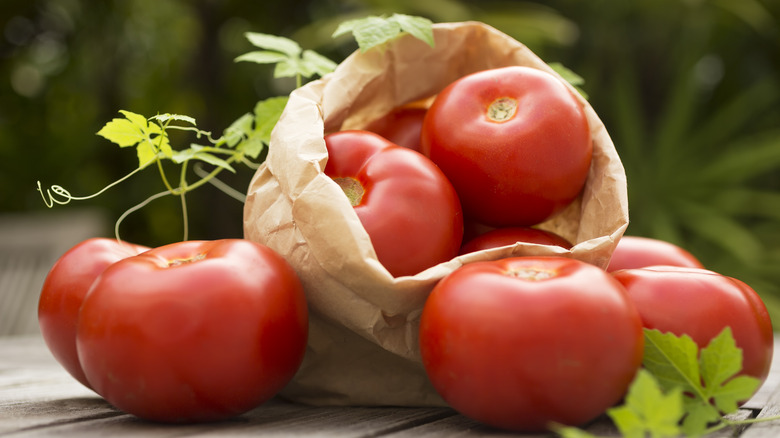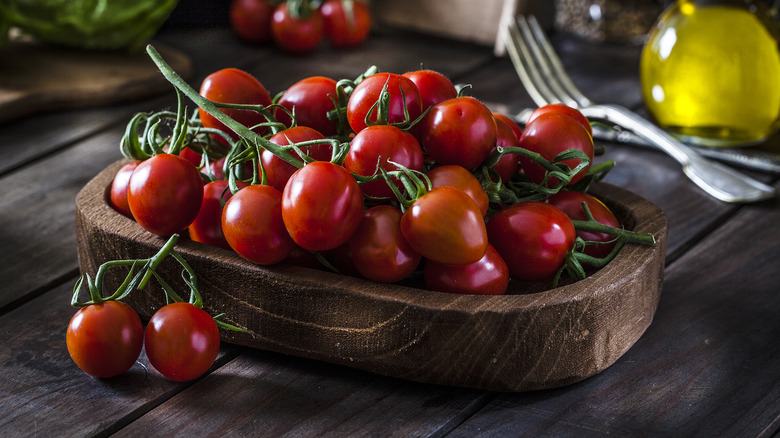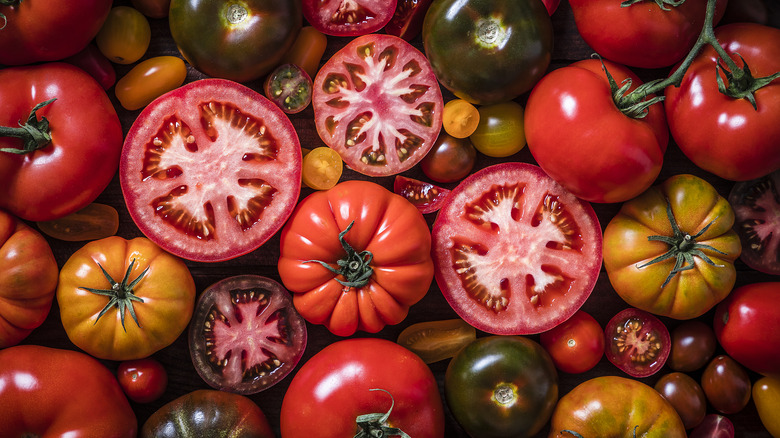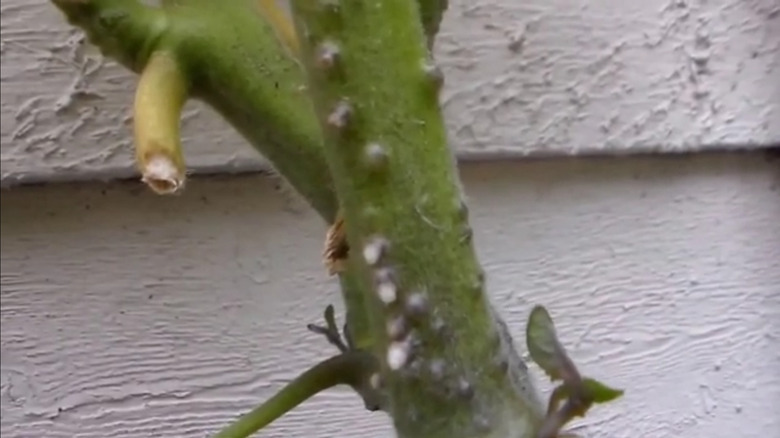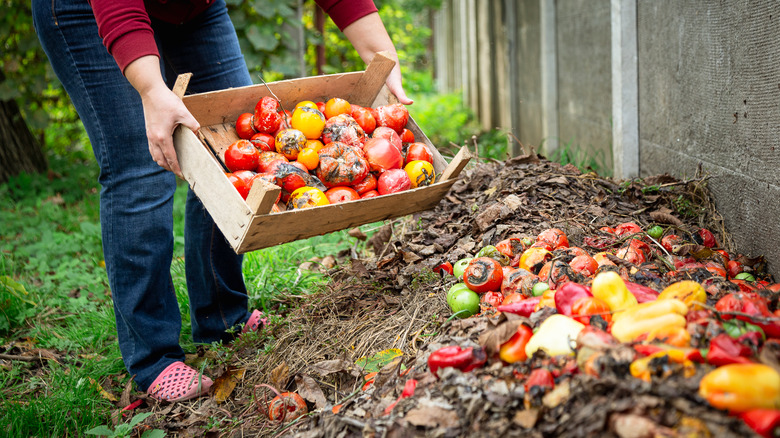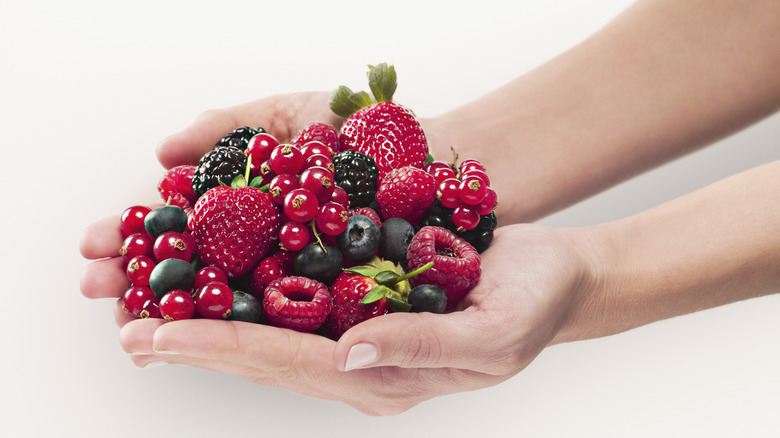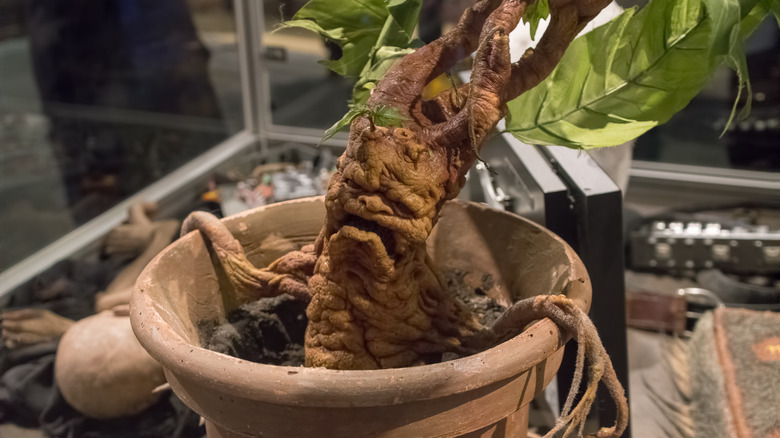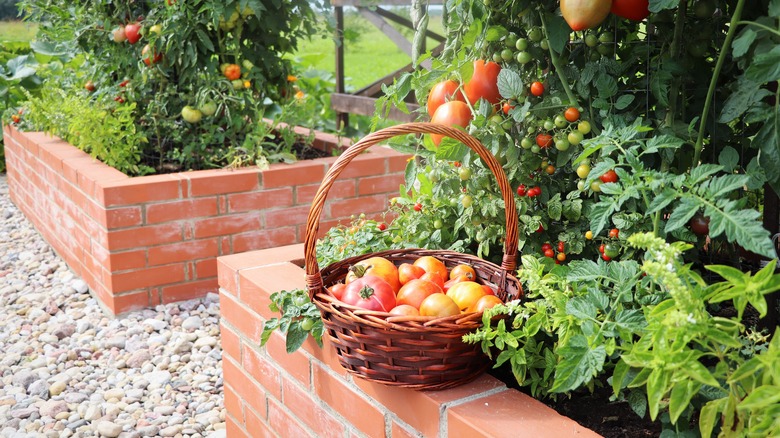12 Facts You Didn't Know About Tomatoes
The tomato. For lovers of this acidic vegetable, it's the crown on a tasty burger, the zest in pasta sauce, and the not-so-secret ingredient that makes salsa the best part of chips and salsa. For haters, the tomato, as a nightshade, is an exacerbator of autoimmune diseases and creator of painful canker sores on the tongue and gums. To add insult to injury, the tomato also comes with a story so filled with poison and intrigue that it puts any fairy tale by the Grimms brothers to shame.
The tomato's identity crisis comes from the fact that it's the cousin of some of the deadliest plants alive, like the foxglove, oleander, or hemlock. To make things even more confusing, the botanical classification of tomatoes suggests that they'd taste great in a salad with peaches and bananas or possibly as a topping for vanilla ice cream. Clearly, something wonky is afoot here, which is why we've gathered together these 12 facts about tomatoes to help set the record straight.
1. The first tomatoes grew in Ecuador 80,000 years ago
From a foodie standpoint, we owe a lot to the Western hemisphere. Aside from giving the world potatoes and corn, it also birthed one of the planet's most popular plant foods, the tomato. Some disagreement about the tomato's origin has been tossed about by the scientific community. So, to make things easier, let's look at the birth of tomatoes in terms of wild tomatoes versus cultivated ones.
Genetic research suggests that cherry-sized tomatoes popped up about 80,000 years ago. No human hands touched those tomatoes, except maybe to pull them off the vine and eat them. Mother Nature's hands were the cultivators here. Cultivated tomato crops sprang up about 7,000 years ago. Those little blueberry-sized babies were the offspring of the tomato's ancestor. The tomatoes resulting from those cultivation efforts produced cherry-sized tomatoes, though apparently, no one let early farmers know that tomatoes that size already existed in the wild. Blame it on the limitations of pre-Internet communication.
What isn't disputed is where tomatoes originated: South America. Naturally, some disputes again arise regarding which South American country gets first dibs. Some say Peru. Others say Ecuador. In any case, regardless of their exact origins, tomatoes eventually made their way around the world.
2. More than 10,000 varieties of tomatoes exist
If you're into foodie travel, chasing after the different tomato varieties that exist here on Planet Earth could be an Around-the-World-in-80-Days foodie odyssey. In all likelihood, such an adventure would last longer than 80 days due to the sheer volume of different tomato varieties. Conservative estimates put the number of tomato varieties at 10,000, give or take. The highest estimates put the variety count between 19,000 and 25,000. Some of those varieties you likely know — roma, campari, and cherry, while others, like the Jaune Du Chardonne and Agrappoli De Lnverno, sound exotic, like something you should consume with a diamond-encrusted Champagne brut Goût de Diamant and a few slices of brie.
All tomatoes have their place and their type, as it turns out. Five basic types of tomatoes exist: the plum tomato, beefsteak tomato, cherry tomato, standard globe tomato, and the Oxheart — heart-shaped beauties that might look way cool on a Valentine's Day pizza. Also, tomatoes have an extra cool factor when it comes to color. A trip to the grocery store is mostly filled with a sea of red tomatoes. However, tomatoes come in a variety of colors, too. Aside from red, it's not impossible to see green, yellow, purple, and even striped and spotted ones.
3. Scientists are growing tomatoes in space
For those of us who consider ourselves "Trekkies," the thoughts of outer space usually include playing around in the holodeck, having a Bloody Mary in the Ten Forward lounge, and experiencing our first away-team mission. It probably doesn't include thoughts of growing tomatoes because, well, how so un-SciFi-like. It's probably good that scientists are more forward-thinking about the steps we must take to get to having that Bloody Mary from where we are now.
Plant seeds have been visiting space since the late 1960s. Actual attempts to grow plants and, eventually, food in space have been happening since the 1980s, though those attempts remained largely the realm of trained scientists. With the advent of programs like NASA's Tomatosphere and Veg-05 experiment, the mission of growing food in space expanded beyond astronauts and into the classroom and society. The Tomatosphere introduces school kids in the US and Canada to concepts around growing food in space using tomato seeds that have been in space or space-like environments. The Veg-05 in 2023 experiment actually saw tomatoes being grown in space. This experiment provided scientists with info about growing crops, tomatoes, in this case, in space. While this will help them eventually grow their own food on missions, it also has applications on Earth, including horticultural therapy for the elderly. These experiments and educational programs represent some of the first steps that scientists will have to take in order to get to that Bloody Mary in Ten Forward.
4. Americans eat more than 20 pounds of tomatoes a year
Reports differ as to how many tomatoes Americans eat per annum, though the average seems to be somewhere between 19 pounds and 24 pounds. However, these numbers can be deceiving. Some stats suggest that Americans eat around 20 pounds of fresh tomatoes (or so) per year. However, many of the tomatoes consumed aren't farmer's market fresh at all.
In 2015, the Washington Post reported that Americans eat about 100 acres of pizza per day. This is just the kind of reporting that allows people to justify calling tomato sauce and ketchup salad. We're only slightly kidding, of course, but the Washington Post stat points toward an important industry stat. Americans consume about 75% of their tomatoes in the form of canned and/ or processed tomatoes, according to Farm to Institution New York State.
The USDA's numbers differ slightly from FNYS's numbers, but they tell a similar story. The Department of Agriculture reports that 24% of the tomatoes Americans eat at home come from spaghetti and pasta sauce, while 32% of the tomatoes Americans eat at restaurant tables come from pizza. Around 17% of Americans' away-from-home tomato consumption comes from pasta sauces. Altogether, those away-from-home numbers add up to 73%.
In plainer English, when Americans go tomato hunting, they're more likely to seek out that 100 acres of pizza than take themselves to an acre that allows them to pluck tomatoes straight off the vine, in a manner of speaking.
5. You can grow roots for a tomato plant anywhere along the stem of an existing plant
While being human comes with many benefits, including the ability to nosh on yummy food all day, our biology does have its drawbacks, particularly when you compare it to tomato plants. Without getting too graphic, it's probably safe to say that it would be quite remarkable if you could grow another leg out of your neck or your ear should you find yourself short of one. Alas, you can't, but tomato plants have the ability to grow "new legs" of sorts nearly anywhere should their own legs come up short. Known as "root primordia," you often find these "mini-legs" on the stems and even sometimes on the leaves.
While these nubs of roots, also called "adventitious roots," make cloning plants easier – that is, growing new tomato plants from cuttings – these itsy bitsy roots on your tomato plants also tell a story. If you water your tomato plants too much, the root primordia may start to grow as a protective measure. This means the plant's main roots may be getting too much water, so it is hedging its bets by growing new roots elsewhere. If the old roots fail, the plant can grow 10 more in their place on its stems or leaves, basically the plant equivalent of growing roots out of its ear.
See? We told you that humans sometimes are at a biological disadvantage compared to tomato plants.
6. Tomatoes are a good excuse to visit Epcot Center at Walt Disney World
It's fair to say that taking a trip to Walt Disney World always comes with some pretty fantastical experiences. True enough, most Disney trekkers go because they want to experience ride experiences like Guardians of the Galaxy, the various Star Wars rides, or Teamboat Springs. Others, who are botanically minded, may find that a slow row around the Living With the Land exhibit has just as much to see, including a recording-breaking tomato tree. Walt Disney World's Lycopersicon esculentum, or giant tree tomato, grew a whopping 32,194 tomatoes in one year. While that record-breaking haul happened in 2016, Disney's tomato tree is still part of Epcot in the Behind the Seeds tour.
Yong Huang, the manager of agricultural science at Epcot, introduced the tree to Walt Disney World. It's also important to note that Disney isn't just growing a gigantic tomato tree because it's impressive to have a tree that produces a thousand pounds of tomatoes. The fruit from the tree winds up on plates around Walt Disney World, so it has a very practical function, as well as being something interesting to see.
7. People threw tomatoes (and other food) at terrible actors in ancient times
Long before the Rotten Tomatoes website existed, there were audience members who had too many rotten tomatoes and not enough bad actors to throw them at. Actors in ancient days regularly experienced tomatoes in the face – really, any rotting fruit or vegetable – that displeased audience members could get their hands on. If it was edible, in the various stages of rotting, and fit conveniently in the hand, it was fair game to toss in moments of displeasure.
While tradition tells us that Shakespearean actors often found themselves on the receiving end of this botanical vitriol, political and religious leaders also experienced this ancient tossed salad, as it were. Shakespeare might have retold tales of Caesar getting the proverbial pie in the face, but the practice of food riots in response to politics actually got their start in real life during the time of Vespasianus Caesar Augustus. However, he got his lumps from turnips instead of tomatoes. We're sure this hurt a whole lot more, which is probably why we still know about something that happened in A.D. 63.
Despite how unseemly this might appear today, people in Shakespeare's day loved it. Elizabethan theater had something for everyone, and if the upper crust spent their time in the balcony breaking bread with the rich and important, so to speak, the lower crust hung out in front of the stage, tossing tomatoes at weary actors. It was all in a night's entertainment.
8. Europeans in the 1700s thought tomatoes were poisonous
Silver spoons. Pewter plates. Dinner with the enemy for political gain. In past centuries, it was a toss-up as to whether or not you'd survive dinner, what with the ubiquity of poisons being a thing and all. And while it's true that the nobility had cupbearers for just such a purpose – that is, to avoid being poisoned while at dinner with their enemies – much of the poisoning that was done at the table was by a person's own hand or, rather, by his or her own plate and spoon.
Certainly, no period drama on TV would have a Games-of-Thrones-ish kind of authenticity without a table filled with pewter plates and silver spoons. But it was these very royal dinner implements that caused the nobility to be called "blue bloods." Read: Their silver spoons turned their blood blue. These practices also caused them to think that tomatoes were as poisonous as a fairy tale witch's apple. It was the pewter's lead content, mixed with the acid in the tomatoes, that caused the lead to leach out of the plates and into the tomatoes and, ultimately, the aristocrat's mouth, conveniently carried there by his or her own fork. A hundred cupbearers couldn't have stopped that kind of poisoning. And speaking of poisoned apples, the prevalence of poisoning by lead-filled tomatoes was common enough that it earned tomatoes the nickname "poison apples."
9. Every August, there is a giant tomato fight in Spain
In Elizabethan England, actors may have had to dance a jig on stage to sidestep the tomatoes that audience members threw at them. In modern times, people gather on the streets of Spain to have people throw tomatoes at them on purpose. Called La Tomatina Festival, the town of Buñol, located a stone, or rather, a tomato's throw from Valencia, Spain, this giant food fight has people lining up to lob tomatoes at people from all over the globe. At one time, up to 50,000 people showed up for the food fight, but nowadays, only about 20,000 people get the golden pass to toss each year.
Held on the last Wednesday of August each year, around 140 tons of tomatoes find their way out of the revelers' hands and into the faces of unsuspecting yet smiling onlookers. And while the "World's Biggest Food Fight" makes up the main event, the days leading up to the festival are a foodie's traveler's dream. Fireworks light up the sky. Cook-offs match chefs' talents, stir for stir. And Spanish parades fill the streets with joy. Given that it's been going for 70 years, with a few hiatuses here and there, it's even more impressive when you realize it all started on a whim in 1945. While there may be better ways to use up over-ripe tomatoes, we doubt that any of them are quite as much fun.
10. Botanically speaking, tomatoes are berries
If you're making a sandwich, a savory one, anyway, you'll likely pile on ingredients like cheddar cheese, maybe some deli meats, mustard and mayo, and, of course, some tomatoes. What you wouldn't put on said sandwich is berries. No blueberries or strawberries will sneak into your roast beef sandwich in this lifetime.
Here's the thing. If you put tomatoes on your sandwich, you are technically dressing your sammy with berries because, from a botanist's point of view, tomatoes are technically berries. To be botanically classified as a berry, a fruit or vegetable must contain seed or seeds and be encased in a fleshy plant ovary. This makes many of our favorite vegetables, like tomatoes, eggplants, and another sandwich favorite, avocados, fruits.
Naturally, there is something more to complicate the "Is a tomato a fruit or a vegetable" question. Nix v. Hedden, a 19th-century legal case, declared that tomatoes must be considered a vegetable according to the parameters laid out by the Tariff Act of March 3, 1883. Basically, the tariff allowed for the taxation of imported vegetables but not fruits. At the time, John Nix, the plaintiff in the case and a food importer, argued that since tomatoes were botanically a fruit and not a vegetable, then there should be no tax on them. The US Supreme Court disagreed, using the rationale that, since the public thought of and used tomatoes as vegetables and not fruits, then tomatoes, for taxation purposes, would be vegetables.
11. Tomatoes were classified as mandrakes in the 16th century
For "Harry Potter" fans, a mandrake is a yowling root that has an eardrum-piercing scream that's deadly under certain circumstances. In ancient times, mandrake roots, the kind upon which JK Rowling's mandrakes were based, were so named because those roots looked like a man and were believed to scream like a banshee once they were freed from the soil which housed them. It should be noted that the tomato is part of the Solanaceae family, which makes it related to the flowering mandrake that the ancient world knew so well. The ancients loved the rooty mandrake because, in the right dose, it provided them with a painkiller. It was also good as an aphrodisiac and for fertility.
On the downside, mandrake root causes dizziness and hallucinations in large doses. It was Pietro Andrea Mattioli, a 16th-century botanist, who concluded that tomatoes were not only nightshades – that is, part of the Solanaceae family – but also mandrakes. Mattioli's declaration made tomatoes both tempting and deadly, though there is no word on whether or not he thought they'd scream given the right circumstances.
Down the road, people would learn that not all nightshades lead to an early grave, including two of people's favorites, tomatoes and potatoes. However, that took a while because it did seem for a time that tomatoes were deadly due to the practice of eating them off of pewter plates, which contained lead, and ingesting lead will, most decidedly, kill you.
12. People once grew tomatoes as ornamental plants
Roses. Petunias. Orchids. Tomatoes. If you've ever played that game on "Sesame Street," then you know that you must decide which one is not like the other. Right away, you'd probably pick the tomato plant as the one that's different from the other plants on the list. By modern standards, the first three are ornamental plants, the kind that you want to decorate your lawn and flower garden. The last one is a vegetable plant.
But once upon a time, people viewed tomato plants differently than they do today. Because people thought tomatoes would kill them, they relegated the nightshade to the ornamental side of their gardens. In all fairness, tomatoes do flower, sporting a yellow, five-petaled beauty at the right time of the year. And in terms of making it ornamental, it didn't hurt that the fruit of the tomato appealed to the eyes, too.
During its ornamental days, people called the tomato plant the "The Apple of Paradise" or "The Apple of Love," depending on where a person lived in Europe. Plant collectors continued to think of tomatoes as ornamental plants until the 1800s, which isn't to say that some curious home gourmands weren't tomato curious. The boldest ones began cooking with tomatoes by the 16th century. Eventually, with enough time and cooking, tomatoes earned the status they enjoy today as a savory fruit favorite.
